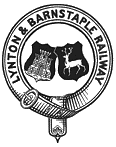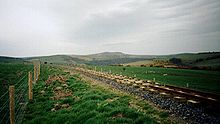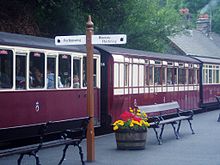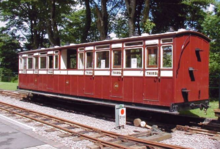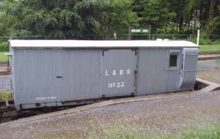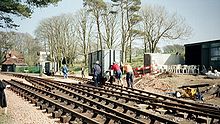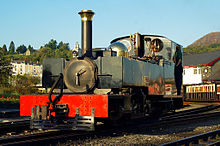
Lynton and Barnstaple Railway
Background Information
SOS believes education gives a better chance in life to children in the developing world too. SOS Child sponsorship is cool!
|
|
|
|---|---|
| Locale | Exmoor, Devon, England |
| Terminus | Lynton & Lynmouth |
| Commercial operations | |
| Name | Lynton & Barnstaple Railway |
| Built by | Promotor: Sir George Newnes, Bart. Engineer: James Szlumper Contractor: James Nuttall |
| Original gauge | 1 ft 11 1⁄2 in (597 mm) |
| Preserved operations | |
| Owned by | Lynton and Barnstaple Railway Trust |
| Operated by | Lynton and Barnstaple Railway Co. Ltd. |
| Stations | 2 |
| Length | 0.9-mile (1.4 km) |
| Preserved gauge | 600 mm (1 ft 11 5⁄8 in) |
| Preserved era | Woody Bay: mid-1930s |
| Commercial history | |
| Opened | 11 May 1898 |
| Closed | 29 September 1935 |
| Preservation history | |
| 1979 | L&BR Association formed |
| 1993 | Railway Company formed |
| 1995 | Woody Bay station purchased |
| 2000 | Association reformed as Trust |
| 2004 | Woody Bay reopened |
| 2005 | Bridge 67 reinstated |
| 2006 | Killington Lane opened |
| 2007 | Over 100,000 passengers carried since reopening |
| 2008 | L&B's first steam loco since 1935 - "AXE" - returned to steam |
| 2010 | " Lyd" - visits Woody Bay |
The Lynton & Barnstaple Railway (L&B) opened as an independent railway in May 1898. It was a single track narrow gauge railway slightly over 19 miles (31 km) long running through the rugged and picturesque area bordering Exmoor in North Devon, England. Although opened after the 1896 Light Railways Act came into force, it was authorised and constructed prior to that act. Therefore, as with all other railways, it was authorised under its own Act of Parliament and built to higher (and more costly) standards than similar railways of the time. In the United Kingdom it was notable as being the only narrow gauge line required to use main-line standard signalling. For a short period the line earned a modest return for shareholders, but for most of its life the L&B made a loss. In 1922 the L&B was taken over by the Southern Railway, and eventually closed in September 1935.
The Lynton & Barnstaple Railway Association was formed in 1979; and a short section was reopened to passengers in 2004. This was extended in 2006; and the following year plans were announced to open nine miles (14 km) of track, linking the station at Woody Bay to both Lynton (at a new terminus on an extension to the original line, closer to the town) and Blackmoor Gate, and to a new station at Wistlandpound Reservoir.
History
Following the opening of the Devon and Somerset Railway to Barnstaple, there were calls for an extension to serve the twin villages of Lynton and Lynmouth, which were popular with holiday-makers.
Through the middle of the 19th century, several schemes were proposed, from established railway companies and independent developers. One scheme suggested electric power, while another proposed a line from South Molton. None of these schemes offered sufficient prospects to encourage investment, and few got further than initial plans.
Due to the difficult terrain, one scheme suggested a gauge of 1 ft 11 1⁄2 in (597 mm), already in use by the Festiniog [ Sic] Railway Company and elsewhere, to ease construction. This scheme was supported by Sir George Newnes who became chairman of the company. The Lynton & Barnstaple Railway Bill was passed on 27 June 1895, and the line opened on 11 May 1898 with public service commencing on 16 May, connecting with trains from Waterloo on the Ilfracombe Branch Line at Barnstaple Town.
The scheme did not meet with universal enthusiasm, and from the beginning, there were some who doubted the true intentions of the promoters. Although many of the sinuous curves and deviations were due to having to maintain a 1 in 50 gradient where there was no leeway (most observers being oblivious to the fact that a straighter shorter line would have made the gradient even steeper), several were due to resistance by local landowners along the route.
A guide published whilst the line was being built stated:
| “ | On the highest point at Lynton a pretentious mansion has been built for himself by the proprietor of a certain well known publication, whom some look on as the benefactor and others as the evil genius of the place. Through his enterprise it is that the "lift" was made in 1888, to be cursed by conservative and artistic souls, but blessed by unwieldy bodies and rheumatic limbs; he has also favoured the railway, now a fait accompli, and the pier which seems so much wanted. Yet whatever may be said of the railway, there is good reason for doubting if the pier would be a real advantage. It would certainly flood the place with a class of excursionists for whom there is little accommodation, and on whom, for the most part, its characteristic beauties would be thrown away. | ” |
The L&B seldom attracted sufficient passengers to remain viable. The journey of nearly twenty miles took on average an hour and a half. To satisfy several influential residents, the terminus at Lynton was some distance from the town itself, and from the cliff railway to Lynmouth.
Declining tourism during World War I, improved roads, increased car ownership further depleted the line's income until it was no longer economic. A guidebook published in 1921 described the situation:
| “ | The railway which has made this corner more accessible is of narrow gauge, requiring a change of carriage at the Town station, Barnstaple. ... Unfortunately, this line does not seem to be a financial success, and its service, out of season at least, is not a very liberal one. | ” |
Despite numerous cost-saving measures and extra investment in the line, the Southern Railway was unable to reverse the trend, and closed the line.
The last train ran on 29 September 1935. An observer at the time wrote:
| “ | Rarely, if ever before, has the closing of a railway aroused such a keen interest as has been awakened throughout the country by the running of the last trains over the narrow gauge Barnstaple-Lynton section of the Southern Railway. This is to be attributed very largely to the unusual character of the line and the magnificent scenery through which it passes. | ” |
The Southern removed everything they could use elsewhere, and by 8 November, had lifted the track from Lynton to milepost 15⅓ - on the Barnstaple side of Woody Bay station. On 13 November an auction was held, although the railway failed to attract much interest. Most rolling stock, and every loco except for Lew, was scrapped at Pilton. Some coaches were sectioned for use as garden sheds. Third class seats became garden furniture, and first class seats found their way into local snooker halls and Masonic Lodges. In December, Plymouth ship breaker Sidney Castle won the tender to dismantle the railway. The remaining track was lifted by June 1936, and in September, surviving loco Lew was shipped to Brazil. The stations and track bed were auctioned in 1938.
The L&B had an exemplary safety record, and no members of the public were killed or injured during its 37-year existence, although accidents at Braunton Road and Chumhill did claim the lives of three track workers.
Route
The route of this diminutive railway and the scenery through which it passes, has been described many times, such as in a 1920s guide to the area:
| “ | The line at first keeps up the winding course of the Yeo with Pilton church tower on the left, and that of Goodleigh presently, on the right, marking a side valley, for which the train stops at Snapper Halt, whence, by Goodleigh one might have an alluring ramble back to Barnstaple. Chelfham (pron. Chellam) is reached by a fine viaduct over the tributary stream, where 2 miles (3.2 km) east stands Stoke Rivers, through which the above round might be extended. The line has now left the Yeo, mounting eastward up the Bratton Valley to Bratton Fleming Station near the lofty village of Bratton Fleming. The next station is Blackmoor (900 ft), lying under the tumuli of Kentisbury Down to the left, whence one might descend on foot to Lynton and Lynmouth (7 miles) or Ilfracombe (10 miles) from the crossroads at Blackmoor Gate. The railway has next to wind around the deep hollow in which lies Parracombe (Fox and Geese Inn) [ sic], where, near the halt platform, can be seen the tower of the old church, another of those said to have been built in expiation of Thomas à Becket's murder. Hence flows the Heddon water, which one might follow down its beautiful course by the Hunter's Inn. The cyclist will find a way diverging from the main road a little beyond Parracombe. At the last station, Wooda Bay*, two miles (3 km) behind this place and its neighbour Trentishoe, the line has reached a highest point of about 1,000 feet (300 m). Beyond this, it crooks down the valley of the West Lyn (best glimpses on right hand), past Caffyn's Down Halt (for the golf links), ending some half-mile behind Lynton, and over a mile by the zig-zag road from Lynmouth. The road (17 miles) keeps pretty much the course of the railway, except in the central stage, where it strikes a mile further north to Loxhore, before leaving the valley of the Yeo, then rejoins the railway at Blackmoor. |
” |
( *Note: Wooda Bay station was actually renamed Woody Bay in 1901. The geographical feature Woody Bay after which the station was named was the subject of an attempt to develop it as a tourist resort to rival Lynmouth; a pier was even constructed. The developers felt that the spelling "Woody" was more attractive to tourists, and so changed it from the original "Wooda"; the station name was changed accordingly.)
As well as several foot- and cycle-routes which can still be followed today, the hostelry in Parracombe mentioned in the article remains a popular venue (although the geese are now singular).
Gradient profile
The L&B rises and falls several times along its length. Starting at 15 feet (4.6 m) above sea level, The first 33⁄4 miles (6.0 km), through Barnstaple, and along the Yeo Valley stays relatively level. Collard Bridge marks the start of an 8-mile (13 km) climb, mainly at one in fifty, to Blackmoor Gate. A shallower down-gradient follows, of about 2 miles (3.2 km), towards Parracombe Bank, and the start of another climb, of about 21⁄2 miles (4 km), to Woody Bay — at 1,000 feet (305 m), the highest railway station in southern England. The line then falls, again mostly at one in fifty (2%) - to Lynton & Lynmouth station, still 700 feet (213 m) above the sea, and hidden by the landscape from the town of Lynton. The minimum radius on curves was 5-chain (100 m).
Rolling stock
One of the most distinctive aspects of the L&B was its rolling stock, with the locomotives appearing originally in a livery of plain lined Holly green, later on a black base, with chestnut under-frames, hauling passenger carriages coloured terracotta with off-white upper panels, and light grey goods wagons. The schemes were simplified as individual vehicles were repainted. With the take over by the Southern and arrival of Lew the livery was slowly changed to Maunsell Green for locos and passenger stock, and umber for the goods wagons. The loco headlamps which had been black under the L&B were re-painted red.
Locomotives
At least four contractors' locomotives were used for construction. Unusually, some of the temporary track was wider than the final gauge - the section around Parracombe Bank for example, spanning the Heddon valley, was built to 3 ft (914 mm) gauge, with a locomotive known as Winnie. A fifth locomotive - perhaps named Spondon - may also have been used, although little is known of either of these. In 1900, Kilmarnock was sold by the L&B. It is believed to have been left behind by James Nuttall, as a result of the financial problems and litigation between railway and contractor.
The L&B used only coal-fired steam motive power. In 1896, the Hunslet Engine Company submitted two designs (a 2-4-2T and a 4-4-0T), but eventually an order was placed for three 2-6-2Ts from Manning Wardle & Co of Leeds. The locos were named after local rivers: Yeo, Exe, and Taw. These were supplemented by a 2-4-2T, Lyn, built by the Baldwin Locomotive Works of Philadelphia, USA, as the Company realised that three locos would be insufficient. Baldwin was selected as they could deliver the loco — based largely on standard components — more quickly than domestic suppliers, who had a backlog of orders, caused by a national engineering dispute over the 8 hour working day resulting in a lock-out by employers from July 1897 and January 1898. After construction by Baldwin, the loco was shipped across the Atlantic in parts, and re-assembled at Pilton by railway staff. It first steamed in July 1898. The Manning Wardles were delivered ahead of the lock-out, and Yeo and Taw were used in the final stages of construction. Exe was stored locally in a stable, where she received the unwelcome attention of thieves who stole various brass fittings and fixtures.
In 1923 the L&B was absorbed into the Southern Railway, and began an upgrade programme. All locos & coaches was repainted in Southern Maunsell Green livery, the wagons were repainted in Southern Umber livery and track and buildings were improved. A fifth locomotive, Lew was purchased in 1925, with improvements to the original Manning Wardle design.
Fate of Lew
Although bought at the auction (it is believed by Barwicks of London) by December 1935, Lew was working for Sidney Castle, the dismantler of the railway. This work was completed by July 1936 and in September, Lew was moved by rail to Swansea and loaded onto the S.S. Sabor destined for the port of Pernambuco (since renamed Recife), Brazil. Most of the relevant shipping records were destroyed in World War II, Lew then just vanished and despite several attempts, no trace of the locomotive, or evidence of its fate, has so far been found.
Passenger stock
Sixteen passenger carriages were delivered for the opening. Built by the Bristol Wagon & Carriage Works Co. Ltd., these comprised six different types, all the same size, being 39 ft 6 in (12.0 m) long, 6 ft (1.8 m) wide, (7 ft 4 in/2.2 m over steps) and 8 ft 7 in (2.6 m) high — large by narrow gauge standards — and certainly superior to any previous British narrow gauge stock.
The coaching stock was extremely solidly constructed, and offered levels of accommodation far in advance of anything else at the time - certainly compared to any other narrow gauge railway. Almost 70 years later, the design was used as the basis for a new rake of carriages built by the Ffestiniog - testament to the excellence of the original design.
The body for coach 17 was built in 1911, by local firm Shapland and Petter, and mounted on a steel underframe constructed by the railway in its own workshops at Pilton. Marginally longer than the earlier coaches, it contained both smoking and non-smoking accommodation for first and third class passengers, as well as the brake van space.
Goods stock
The Southern Railway introduced several new items of goods stock, and also purchased two ex-War Department travelling cranes for the line.
Goods-only trains were a rarity, and the usual practice was to attach goods wagons to any scheduled passenger services. Whilst the shunting of wagons at intermediate stations no doubt added to the interest of the tourist and occasional traveller, it also added marginally to the journey time.
The open goods wagons were originally delivered with a single top-hung side door on each side, but these proved inefficient, and all were eventually converted to side hung double doors. By 1907, most had been fitted with tarpaulin rails. The goods vans used the same underframe, and were fitted with double sliding doors on each side.
The bogie open doors were also originally top-hung, but converted by the railway at Pilton.
Wagon No. 19 was originally used by the contractors. After the railway opened, it was modified and entered revenue service in 1900. At only 6 tons it was used often in preference to a 8 ton wagon as it reduced the overall weight of a train.
Van 23 - now restored and at Woody Bay - was built at Pilton by the L&B. Unlike all other L&B stock, its underframe was entirely made of wood.
The travelling cranes were ex-WD stock, and fitted with outriggers, rated at 3 tons with a fifteen-foot radius, 4½ tons at 11 ft 6 in (3.51 m) Intended as recovery cranes in the event of a derailment, neither saw much use. One crane, with its match truck, was kept in the long headshunt at Pilton, the other was put to use in Lynton goods yard.
The 1927 bogie goods vans were originally fitted with heavy diagonal wooden cross braces at each end, but these were later replaced with single diagonal angle-iron braces.
|
|
|||||||||||||||||||||||||||||||||||||||||||||||||||||||||||||||||||||||||||||||||||||||||||||||||||||||||||||||||||||||||||
Present
Seventy-five years after its closure, much of the line is still in evidence. The most spectacular evidence is Bridge 22 - the brick-built Chelfham Viaduct. Fully restored in 2000, its eight 42-foot (13 m) wide arches reach 70 feet (21 m) above the Stoke Rivers valley — the largest narrow-gauge railway structure in England.
The stations at Lynton and Bratton Fleming are now private residences, Blackmoor Gate is a restaurant and Barnstaple Town a school. Chelfham and Woody Bay both serve the new L&B. Chelfham station is used for volunteer accommodation, while Woody Bay is the main centre of operations. Snapper Halt was purchased in 2010 by Exmoor Associates - a private company dedicated to securing trackbed for the restoration of the railway.
A short section of the line reopened to passengers in 2004. Bridge 67 was generously rebuilt as a gift by Edmund Nuttall Ltd. — a firm descended from James Nuttall of Manchester, the main contractors for the original construction — allowing an extension to Killington Lane in 2006. Work is progressing on the next section, towards Parracombe.
Restoration
Unlike the Welsh Highland Railway, the track bed was sold off piecemeal - often reverting to the original owners, paying much less than they had sold it for originally. Although there has been minor development on parts of the route, and Wistlandpound Reservoir has flooded the track bed close to its mid-point, much is still in open countryside, with many sections identifiable.
The Lynton & Barnstaple Railway Association (since 2000, a charitable trust) was formed in 1979. Woody Bay Station was purchased by the Lynton and Barnstaple Railway Company in 1995 and, after much effort, a short section of railway reopened to passengers in 2004. This was extended to over a mile in 2006, with steam and diesel-hauled trains running between Woody Bay and the new, temporary terminus at Killington Lane.
In 1995, the Lynbarn Railway — at the Milky Way, a theme park near Clovelly, was created and operated by L&B volunteers. Profits from this funded the purchase, restoration and reopening of Woody Bay. The Lynbarn was handed over to the park in 2005, once Woody Bay had become established, and continues to operate as part of the attraction.
Little original rolling stock survives, but Van 23 is on display at Woody Bay. Coach 7 and Coach 17 are under restoration off-site. The remains of several other coaches and Goods Van 4 are in storage awaiting reconstruction. The reconstructed coaches will form part of a "Heritage Train" to complement more modern stock.
Coach 2, used as a summer house, is on display (unrestored) at the National Railway Museum York along with the nameplates of the original locos. Coach 15, recovered from Snapper Halt in 1959 and restored by the Ffestiniog Railway in North Wales, has been running there (now as FR Coach 14) for longer than it did on the L&B. Due to the Ffestiniog's smaller loading gauge, the roof profile was altered so it can pass through Garnedd tunnel. In September 2010, Coach 15 visited the L&B with the Lew replica loco, Lyd.
A 1915 Kerr Stuart "Joffre" class 0-6-0T loco was bought in 1983, and named Axe. Restored to working order in 2008, Axe now works most passenger trains at Woody Bay. An 0-4-0WT Maffei named Sid, owned by several L&B members, is also used on the L&B steam service.
The Trust owns two industrial diesel locomotives, one of which Heddon Hall, is often used as backup for Axe and Sid, and for maintenance trains.
A number of other visiting diesel and steam locomotives have also seen service on the line.
Modern replicas
Lyd
A Lynton and Barnstaple Manning Wardle engine, named Lyd, is operational on the Ffestiniog Railway in North Wales.
First Steamed in Spring 2010, Lyd visited Woody Bay in September 2010 - to mark the 75th Anniversary of the closure of the L&B. Lyd first moved under its own steam on 5 August 2010 and then underwent running-in trials before visiting the L&B in September 2010 with former L&B coach 15 and Ffestiniog Railway observation car 102.
Lyn
A replica of the Baldwin, Lyn is currently being constructed. It will be assembled by Alan Keef Ltd.
Yeo
A set of frames for a new Yeo were built by Winson Engineering in 2000, and these are in storage, awaiting further funds to continue the construction.
Prospects
Restoring passenger services from Woody Bay was a major undertaking by the enthusiastic volunteers. Although much of the track bed survives intact, several obstacles — including Wistlandpound Reservoir — must be overcome if the greater part of the route is to be restored, fulfilling the hopes expressed in a card left at Barnstaple on the day after the line closed — Perchance it is not dead, but sleepeth...
In October 2007, the railway announced plans for reinstating enough trackbed to reopen nine miles (14 km) of track, linking the station at Woody Bay to both Lynton (at a new terminus on an extension to the original line, closer to the town) and a new station at Wistlandpound.
Exmoor Enterprise is likely to cost around £30 million, including the building of replica rolling stock, reconstructing original coaches and Van 4, as well as improving the line as an important local tourist attraction. The railway's management predicts the scheme will generate over £70 million for the south west economy within five years.
Working closely with international engineering and design consultants Arup, The L&B Trust held a series of public consultations during May and June 2012, providing information to local communities about plans for obtaining a TWO, and the next phase of the reinstatement, south-west from Killington Lane to Blackmoor, then Wistlandpound, and north-east to Caffyns, and eventually to Lynton.
Longer-term plans see reopening the line towards Barnstaple.

